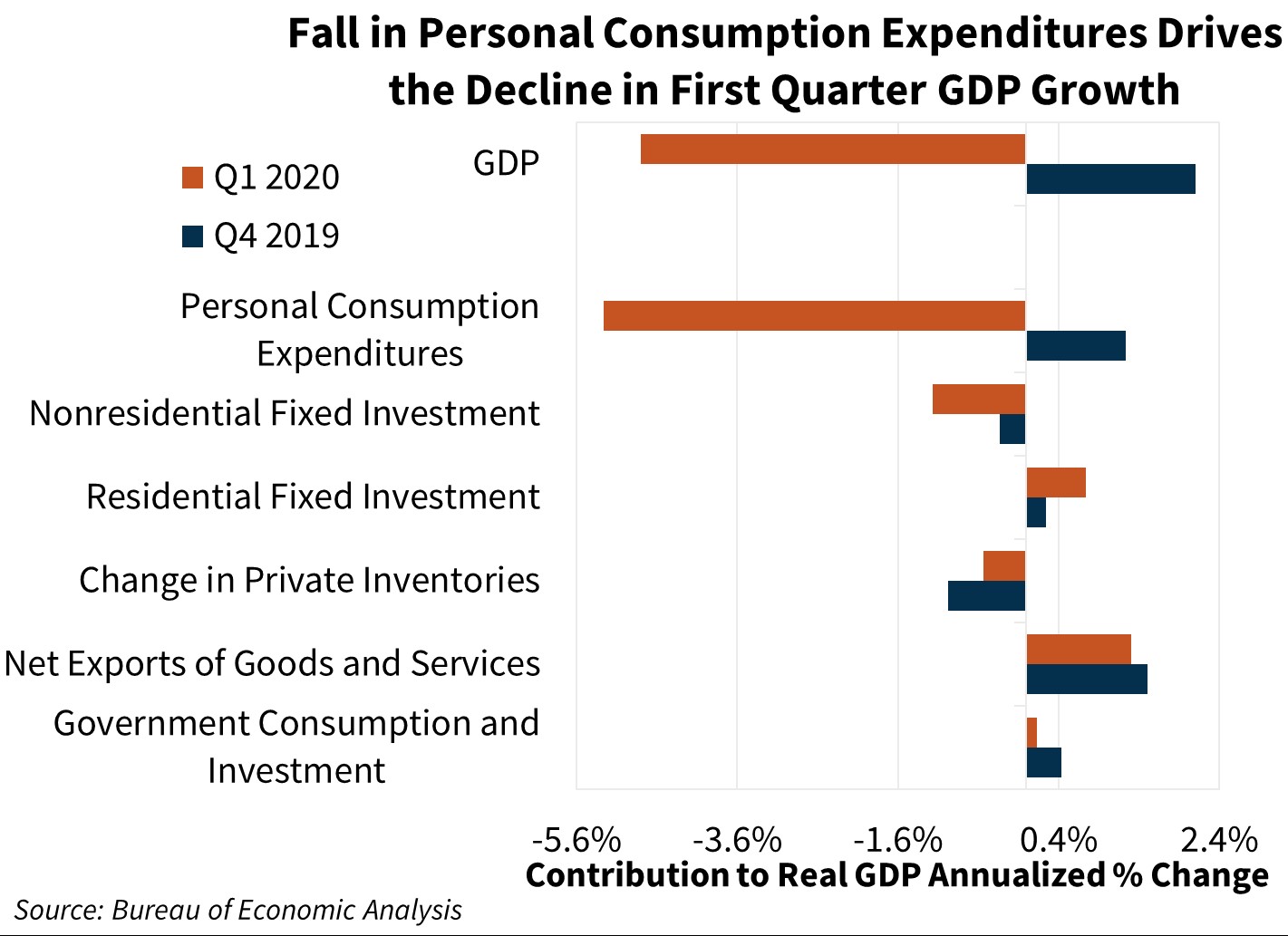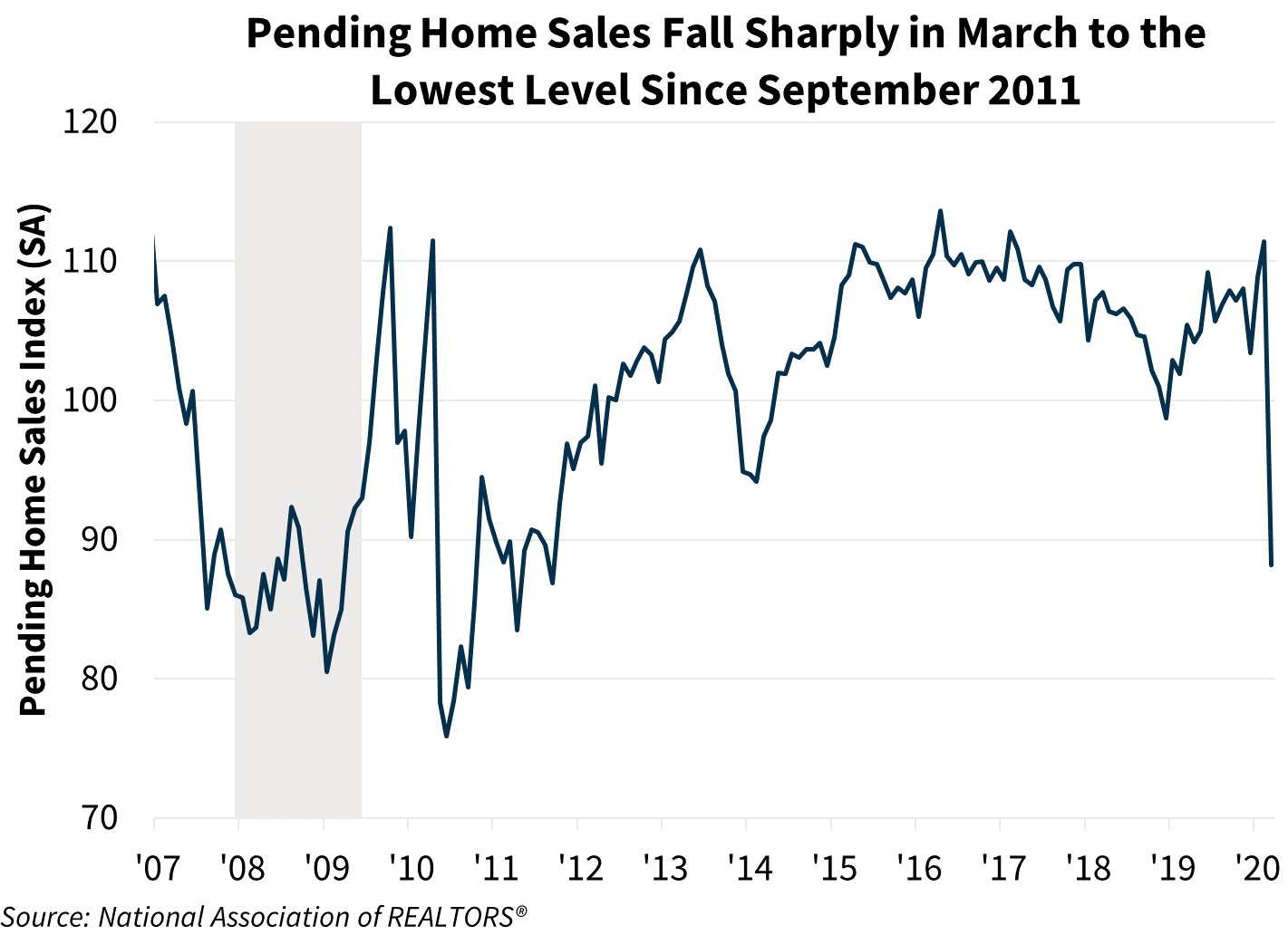The Fed Focuses on Program Rollout as Q1 GDP Contracts by Most Since 2008
Key Takeaways:
- The Federal Open Market Committee (FOMC) announced at its April 28-29 meeting that the federal funds rate would remain unchanged at between 0.00 percent to 0.25 percent and would likely stay there until the economy is fully back “on track.” The FOMC’s statement mentioned that “the ongoing public health crisis will weigh heavily on economic activity, employment, and inflation in the near term, and poses considerable risks to the economic outlook over the medium term.” Since the week of April 1, the Federal Reserve has purchased approximately $631 billion in U.S. Treasury securities, and around $147 billion in mortgage-backed securities (MBS). However, this week the Fed announced it would substantially slow its daily purchases of treasuries and MBS to $10 billion and $8 billion, respectively, down from $75 billion and $50 billion.
- Gross domestic product, adjusted for inflation, fell 4.8 percent annualized in Q1 2020, according to the first estimate from the Bureau of Economic Analysis, the largest decrease since 2008. Real consumer spending (PCE) decreased 7.6 percent as spending on services fell by the largest amount since the series began in 1947, and spending on durable goods posted the largest decline since Q4 2008.
- Personal income, adjusted for inflation, fell 1.7 percent in March, the largest decline since January 2013. The personal savings rate jumped 5.1 percentage points, the largest monthly increase in the history of the series, to 13.1 percent, the highest level since November 1981. The PCE price index decelerated on a year-over-year basis to 1.3 percent, the lowest level of inflation in four months. Core inflation (excluding food and energy) decelerated only one-tenth to 1.7 percent.
- The Conference Board Consumer Confidence Index fell 31.9 points in April to 86.9, the largest decline in the series’ history and the lowest level since mid-2014.
- The ISM Manufacturing Index fell 7.6 points to 41.5 in April, the largest decline since October 2008, and the lowest level in eleven years. The employment index fell 16.3 points to the lowest level in almost 71 years.
- The National Association of REALTORS® Pending Home Sales Index, which records contract signings of existing homes and typically leads closings by one to two months, fell 20.8 percent in March to 88.2, the lowest level since September 2011.
Forecast Impact
The decline of GDP in the first quarter was expected, and we continue to expect an even more severe decline in the second quarter. The falling economic output was driven primarily by a sharp contraction in consumer spending, as consumer confidence fell and businesses closed in March in compliance with state social distancing programs. This decline was unusual in that the service sector led the decline, while nondurable goods spending actually increased due to a surge in spending at grocery stores. While some states have begun to reopen certain businesses, the unprecedented fall in consumer confidence in April supports our expectation of a more significant decline in consumer spending in the second quarter, and thus a much steeper drop in GDP growth. However, the increase in the personal savings rate in March suggests that consumers may have the capacity to resume spending once stay-at-home orders end and businesses begin to reopen. The decline in the April ISM Manufacturing survey also supports our expectation of a further contraction in the second quarter as uncertainty, supply chain disruptions, and social distancing policies will likely lead to a sharp decline in business investment in the second quarter. In housing, the decline in pending sales suggests a pullback in existing home sales, at least in April.


Details on Key Takeaways and Other Releases
- Gross domestic product, adjusted for inflation, fell 4.8 percent annualized in Q1 2020, according to the Bureau of Economic Analysis. Real consumer spending subtracted 5.3 percentage points from GDP growth. Real residential investment rose 21.0 percent, the best pace since Q4 2012, and real government spending increased 0.7 percent. Real nonresidential investment declined 8.6 percent, falling for the fourth straight quarter and by the largest amount in nearly 11 years. Nonresidential investment was dragged down by a 30.6 percent decline in transportation equipment, the largest decline since Q2 2009, along with a deceleration in the growth of intellectual property products, which grew just 0.4 percent annualized compared to 2.8 percent last quarter. While net exports contributed 1.3 percentage points to growth, it was partially offset by inventory investment, which subtracted 0.5 percentage points.
- Personal income, adjusted for inflation, fell 1.7 percent in March, according to the Bureau of Economic Analysis. The PCE price index fell by 0.3 percent, the largest monthly decline since January 2015, while the core PCE price index ticked down by 0.1 percent, the first monthly decline in three years. From a year ago, the PCE price index rose 1.3 percent, a deceleration of five-tenths from last month.
- The Conference Board Consumer Confidence Index fell 31.9 points in April to 86.9. This drop was driven by the largest decline ever in the “present situation” component, falling 90.3 points to the lowest level since the end of 2013. However, the consumer expectations component actually rose 7.0 points, the largest increase since July 2019, to 93.8.
- The ISM Manufacturing Index fell 7.6 points to 41.5 in April (any number below 50 represents contracting activity). The new orders index dropped 15.1 points to 27.1, its lowest level since the end of 2008. The decline in the headline index was partially offset by an increase in the supplier deliverers index, which typical rises in response to high demand, though the increase in April is likely attributable to supply chain disruptions and not overwhelming demand.
- The Housing Vacancy Survey (HVS) for Q1 2020 (not seasonally adjusted) showed that the homeownership rate rose two-tenths to 65.3 percent, according to the Census Bureau. The homeownership rate for people under 35 fell three-tenths to 37.3 percent. The homeowner vacancy rate fell three-tenths from the year prior to 1.1 percent, the lowest level since Q2 1979, while the rental vacancy rate fell four-tenths from a year earlier to 6.6 percent.
- The National Association of REALTORS® (NAR) Pending Home Sales Index fell 20.8 percent in March to 88.2. Sales fell in every region. A NAR survey conducted in mid-April found that approximately “58 percent of Realtors® reported that buyers are using virtual tours and 43 percent said buyers have taken advantage of e-closings.”
Economic and Strategic Research Group
May 1, 2020
Opinions, analyses, estimates, forecasts and other views of Fannie Mae's Economic and Strategic Research (ESR) Group included in these materials should not be construed as indicating Fannie Mae's business prospects or expected results, are based on a number of assumptions, and are subject to change without notice. How this information affects Fannie Mae will depend on many factors. Although the ESR group bases its opinions, analyses, estimates, forecasts and other views on information it considers reliable, it does not guarantee that the information provided in these materials is accurate, current or suitable for any particular purpose. Changes in the assumptions or the information underlying these views, including assumptions about the duration and magnitude of shutdowns and social distancing, could produce materially different results. The analyses, opinions, estimates, forecasts and other views published by the ESR group represent the views of that group as of the date indicated and do not necessarily represent the views of Fannie Mae or its management.
